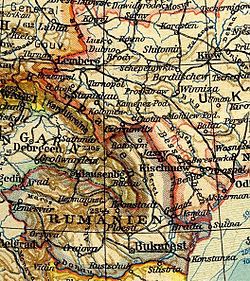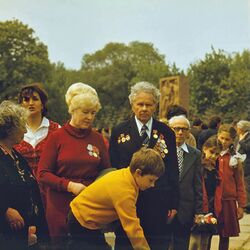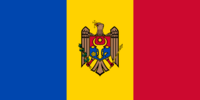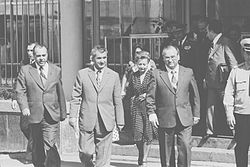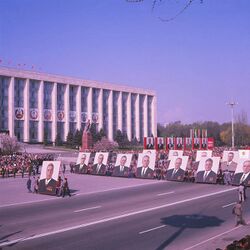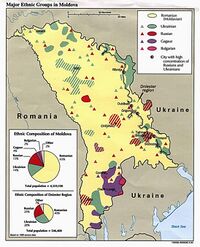Place:Moldavian Soviet Socialist Republic
Moldavian Soviet Socialist Republic Молдавская Советская Социалистическая Республика Republica Sovietică Socialistă Moldovenească Република Советикэ Сочиалистэ Молдовеняскэ | |||||||||||||
|---|---|---|---|---|---|---|---|---|---|---|---|---|---|
| 1940–1991 | |||||||||||||
Motto: Пролетарь дин тоатe цэриле, уници-вэ! (Moldovan) Proletari din toate țările, uniți-vă! (transliteration) "Proletarians of all nations, unite!" | |||||||||||||
Anthem: "Молдова ку доинэ стрэбунэ пэ плаюрь" ("Moldova cu Doine străbune pe Plaiuri") (1945-1980) "Молдова Советикэ" | |||||||||||||
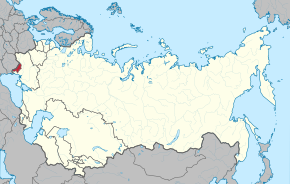 Location of the Moldavian SSR within the Soviet Union. | |||||||||||||
| Status | Soviet Socialist Republic (1940–1991) | ||||||||||||
| Capital | Kishinev | ||||||||||||
| Common languages | Official languages: Moldovana · Russianb Minority languages: Gagauz · Ukrainian | ||||||||||||
| Demonym(s) | Moldavian Soviet | ||||||||||||
| Government | Unitary Marxist-Leninist single-party Soviet socialist republic (1940-1990) Unitary parliamentary republic (1990-1991) | ||||||||||||
| First Secretary | |||||||||||||
• 1941–1942 | Piotr Borodin (first) | ||||||||||||
• 1991 | Grigore Eremei (last) | ||||||||||||
| Head of state | |||||||||||||
• 1989–1991 | Mircea Snegur (last) | ||||||||||||
| Head of government | |||||||||||||
• 1940–1945 | Tihon Konstantinov (first) | ||||||||||||
• 1990–1991 | Mircea Druc (last) | ||||||||||||
| History | |||||||||||||
• Formation | August 2, 1940 | ||||||||||||
• Sovereignty declared | June 23, 1990 | ||||||||||||
• Independence of Transnistria | September 2, 1990 | ||||||||||||
• Independence of Gagauzia | August 19, 1991 | ||||||||||||
• Independence declared | August 27, 1991 | ||||||||||||
• Independence recognized | December 26, 1991 | ||||||||||||
| Area | |||||||||||||
| 1989 | 33,843 km2 (13,067 sq mi) | ||||||||||||
| Population | |||||||||||||
• 1989 | 4,337,600 | ||||||||||||
| Calling code | 7 042 | ||||||||||||
| |||||||||||||
| Today part of | |||||||||||||
| |||||||||||||
Moldavian Soviet Socialist Republic (shortly: Moldavian SSR, abbr.: MSSR; Romanian: Republica Sovietică Socialistă Moldovenească, in Cyrillic alphabet: Република Советикэ Сочиалистэ Молдовеняскэ; Russian: Молда́вская Сове́тская Социалисти́ческая Респу́блика Moldavskaya Sovetskaya Sotsialisticheskaya Respublika), also known to as Soviet Moldavia or Soviet Moldova, was one of the fifteen republics of the Soviet Union existed from 1940 to 1991. The republic was formed on 2 August 1940 from parts of Bessarabia, a region annexed from Romania on 28 June of that year, and parts of the Moldavian Autonomous Soviet Socialist Republic, an autonomous republic within the Ukrainian SSR.
After the Declaration of Sovereignty on 23 June 1990 and until 23 May 1991 it was officially known as the Soviet Socialist Republic of Moldova. From 23 May 1991 until the declaration of independence on 27 August 1991, it was renamed the Republic of Moldova whilst remaining a constituent republic of the USSR. Its independence was recognized on December 26th of that year when the USSR fell.
Geographically, the Moldavian SSR was bordered by Romania to the west and Ukraine to the north, east, and south.
History
Establishment
After the failure of the Tatarbunar Uprising, the Soviets set up an autonomous Moldavian Autonomous Soviet Socialist Republic (Moldavian ASSR) on October 12, 1924 within the Ukrainian SSR on part of the territory between the Dniester and Bug rivers, as a way to prop up the propaganda effort and help a potential Communist revolution in Romania.[1]
On August 24, 1939, the Soviet Union and Nazi Germany signed a 10-year non-aggression treaty, called the Molotov-Ribbentrop pact. The pact contained a secret protocol, revealed only after Germany's defeat in 1945, according to which the states of Northern and Eastern Europe were divided into German and Soviet "spheres of influence".[2] The secret protocol placed the Romanian province of Bessarabia in the Soviet "sphere of influence."[2] Thereafter, both the Soviet Union and Germany invaded their respective portions of Poland,[3] while the Soviet Union occupied and annexed Lithuania, Estonia and Latvia in June 1940,[4][5] and waged war upon Finland (1939–1940).
On June 26, four days after France sued for an armistice with the Third Reich, the Soviet Union issued an ultimatum to Romania, demanding the latter to cede Bessarabia and Bukovina.[6] After the Soviets agreed with Germany that they would limit their claims in Bukovina, which was outside the Molotov-Ribbentrop Pact's secret protocols, to northern Bukovina, Germany urged Romania to accept the ultimatum, which Romania did two days later.[7] The Moldavian Soviet Socialist Republic was thereafter created following the entrance of Soviet troops on June 28, 1940.
The old Moldavian ASSR was dismantled and the Moldavian SSR was organized on August 2, 1940 from six full counties and small parts of three other counties of Bessarabia, and the six westernmost rayons of the Moldavian ASSR (about 40% of its territory).[8] 90% of the territory of MSSR was northeast of the river Dniester, which was the border between the USSR and Romania prior to 1940, and 10% southwest. Smaller northern and southern parts of the territories occupied by the Soviet Union in June 1940 (the current Chernivtsi Oblast and Budjak), which were more heterogeneous ethnically, were transferred to the Ukrainian SSR, although their population also included 337,000 Moldovans.[8] As such, the strategically important Black Sea coast and Danube frontage were given to the Ukrainian SSR, considered more reliable than the Moldavian SSR, which could have been claimed by Romania.[9]
In the summer of 1941, Romania joined Hitler's Axis in the invasion of the Soviet Union, recovering Bessarabia and northern Bukovina, as well as occupying the territory to the east of the Dniester it dubbed "Transnistria". By the end of World War II the Soviet Union had reconquered all of the lost territories, reestablishing Soviet authority there.
Stalinist period: repressions and deportations
Many Bessarabians who fled to Romania before the advancing Red Army were eventually caught by Soviet security forces; a high percentage of these were shot or deported, blamed as collaborators of Romania and Nazi Germany.[10] On June 22, 1941, during the first day of the German invasion of the Soviet Union, 10 people were killed in Răzeni by Soviet authorities and buried in a mass grave.[11] In July 1941 after Operation Barbarossa, a commemorative plaque was installed in Răzeni: "Aici odihnesc robii lui Dumnezeu Diomid, Niculai, Dănila, Nichita, Alexandru, Jurian, Alexandru, Ilie, doi necunoscuţi. Omorâţi mișelește de bolșevici comuniști. 12.VII.1941".[12] A memorial was opened in 2009.
The Soviet authorities targeted several socio-economic groups due to their economic situation, political views, or ties to the former regime. They were deported to or resettled in Siberia and northern Kazakhstan; some were imprisoned or executed. According to a report by the Presidential Commission for the Study of the Communist Dictatorship in Romania, no less than 86,604 people were arrested and deported in 1940-1941 alone. Modern Russian historians put forward an estimative number of 90,000 for the same period.[13] NKVD/MGB also struck at anti-Soviet groups, which were most active in 1944-1952. Anti-Soviet organizations such as Democratic Agrarian Party, Freedom Party, Democratic Union of Freedom, Arcașii lui Ștefan, Vasile Lupu High School Group, Vocea Basarabiei were severely reprimanded and their leaders were persecuted.[14]
A de-kulakisation campaign was directed towards the rich Moldavian peasant families, which were deported to Kazakhstan and Siberia as well. For instance, in just two days, July 6 and July 7, 1949, over 11,342 Moldavian families were deported by the order of the Minister of State Security, Iosif Mordovets under a plan named "Operation South".[10]
Religious persecutions during the Soviet occupation targeted numerous priests.[15] After the Soviet occupation, the religious life underwent a persecution similar to the one in Russia between the two World Wars.
Other deportation campaigns were directed towards the ethnic Germans (whose number decreased from over 81,000 in 1930 to under 4,000 in 1959 due to voluntary wartime migration and forced removal as collaborators after the war) and religious minorities (700 families, especially Jehovah's Witnesses, were deported to Siberia in April 1951 under the plan "Operation North").[10]
Stalinist period: collectivisation
Collectivisation was implemented between 1949 and 1950, although earlier attempts were made since 1946. During this time, a large-scale famine occurred: some sources give a minimum of 115,000 peasants who died of famine and related diseases between December 1946 and August 1947. According to Charles King, there is ample evidence that it was provoked by Soviet requisitioning of large amounts of agricultural products and directed towards the largest ethnic group living in the countryside, the Moldovans. Contributing factors were the recent war, the drought of 1946, and collectivisation.[10]
Khrushchev Thaw: 1956–1964
With the regime of Nikita Khrushchev replacing that of Joseph Stalin , the survivors of Gulag camps and of the deportees were gradually allowed to return to the Moldavian SSR. The political thaw ended the unchecked power of the NKVD/MGB, and the command economy gave rise to development in the areas such as education, technology and science, health care, and industry (except in the fields that were considered politically sensitive, such as genetics or history).
Brezhnev government: 1964–1982
Between 1969 and 1971, a clandestine National Patriotic Front was established by several young intellectuals in Chișinău, totaling over 100 members, vowing to fight for the establishment of a Moldavian Democratic Republic, its secession from the Soviet Union and union with Romania. In December 1971, following an informative note from Ion Stănescu, the President of the Council of State Security of the Romanian Socialist Republic, to Yuri Andropov, the chief of KGB, three of the leaders of the National Patriotic Front, Alexandru Usatiuc-Bulgăr, Gheorghe Ghimpu and Valeriu Graur, as well as a fourth person, Alexandru Șoltoianu, the leader of a similar clandestine movement in northern Bukovina, were arrested and later sentenced to long prison terms.[16]
In the 1970s and 1980s Moldavia received substantial investment from the budget of the USSR to develop industrial, scientific facilities, as well as housing. In 1971, the Council of Ministers of the USSR adopted a decision "About the measures for further development of Kishinev (Chișinău) city" that secured more than one billion rubles of investment from the USSR budget.[17] Subsequent decisions directed enormous wealth and brought highly qualified specialists from all over the USSR to develop the Soviet republic. Such an allocation of USSR assets was partially influenced by the fact that Leonid Brezhnev, the effective ruler of the USSR from 1964 to 1982, was the Communist Party First Secretary in the Moldavian SSR in 1950-1952.[citation needed] These allocations stopped in 1991 with the dissolution of the Soviet Union, when the nation became independent.
Perestroika and the road to independence: 1985–1991
Although Brezhnev and other CPM first secretaries were largely successful in suppressing Moldavian nationalism, Mikhail Gorbachev's administration facilitated the revival of the movement in the region. His policies of glasnost and perestroika created conditions in which national feelings could be openly expressed and in which the Soviet republics could consider reforms independently from the central government.
The Moldavian SSR's drive towards independence from the USSR was marked by civil strife as conservative activists in the east (especially in Tiraspol), as well as Communist party activists in Chișinău worked to keep the Moldavian SSR within the Soviet Union. The main success of the national movement in 1988-1989 was the adoption on August 31, 1989 by the Supreme Soviet of Moldova of the Moldavian language as official, declaration in the preamble of a Moldavian-Romanian linguistic unity, and the return of the language to the pre-Soviet Latin alphabet.[18] In 1990, when it became clear that Moldavia was eventually going to secede, a group of pro-Soviet activists in Gagauzia and Transnistria proclaimed independence in order to remain within the USSR. The Gagauz Republic was eventually peacefully incorporated into Moldavia as an autonomous territory, but relations with Transnistria soured. Its sovereignty was declared on June 23, 1990 on its territory.
Independence
On March 17, 1991, Moldova, alongside with the Baltic states, Armenia and Georgia boycotted the union-wide preservation vote with 98.72% in favor without any official sanction.
On May 23, 1991, the Moldavian parliament changed the name of the republic to the Republic of Moldova. Gagauzia declared independence as a republic on August 19, 1991.
Moldova then seceded from the Soviet Union and became a independent sovereign state on August 27, 1991, after the failed coup in Moscow. After that period, on August 22, 1991 at 12:15 pm Kishinev time, the statue of Vladimir Lenin was toppled by protesters in the Moldavian capital.
Independence was quickly followed by civil war in the east of the country (Transnistria), where the central government in Chișinău battled with separatists, who were supported by pro-Soviet forces and later by different forces from Russia . The conflict left the breakaway regime (Pridnestrovian Moldavian Republic) in control of Transnistria - a situation that persists today. The Soviet Union ceased to exist on December 26, 1991 and Moldova was officially recognized as an independent state.
Relationship with Socialist Romania
In the 1947 Paris Peace Treaty, the Soviet Union and Romania reaffirmed each other's borders, recognizing Bessarabia, northern Bukovina and the Herza region as territory of the respective Soviet republics.[19]
Throughout the Cold War, the issue of Bessarabia remained largely dormant in Romania. In the 1950s, research on history and of Bessarabia was a banned subject in Romania, as the Romanian Communist Party tried to emphasise the links between the Romanians and Russians, the annexation being considered just a proof of Soviet Union's internationalism.[20]
Starting with the 1960s, Gheorghe Gheorghiu-Dej and Nicolae Ceaușescu began a policy of distancing from the Soviet Union, but the debate over Bessarabia was discussed only in scholarship fields such as historiography and linguistics, not at a political level.[21]
As the Soviet-Romanian relations reached an all-time low in the mid-1960s, Soviet scholars published historical papers on the "Struggle of Unification of Bessarabia with the Soviet motherland" (Artiom Lazarev) and the "Development of the Moldavian language" (Nicolae Corlăţeanu). On the other side, the Romanian Academy published some notes by Karl Marx which talk about the "injustice" of the 1812 annexation of Bessarabia and Nicolae Ceaușescu in a 1965 speech quoted a letter by Friedrich Engels in which he criticized the Russian annexation, while in another 1966 speech, he denounced the pre-World War II calls of the Romanian Communist Party for the Soviet annexation of Bessarabia and Bukovina.[22]
The issue was brought to light whenever the relationships with the Soviets were waning, but never became a serious subject of high-level negotiations in itself. As late as November 1989, as Russian support decreased, Ceaușescu brought up the Bessarabian question once again and denounced the Soviet invasion during the 14th Congress of the Romanian Communist Party.[23]
On June 22, 1976, Ștefan Andrei underscored to President Gerald Ford, at the White House, that, while it harbored no territorial claims and recognized "the Moldavian Socialist Republic as an integral part of the USSR,” it “cannot accept the idea that Moldavians are not Romanians."[24]
On 1–2 August 1976, Nicolae Ceaușescu, Elena Ceaușescu, Nicu Ceaușescu, Ștefan Andrei, Ambassador Gheorghe Badrus were the first high-level Romanian visitors to Moldova since World War II. On 1 August, they came from Iași and the First Secretary Ivan Bodiul, Kiril Iliashenko, N. Merenișcev escorted them from the border, and on leaving for the Crimea at the Chișinău International Airport on 2 August. The move was widely interpreted as a sign of improved relations.[25] During a meeting, Brezhnev insisted that Ceaușescu himself had the opportunity to see that the Moldavians existed as a separate people with a separate language during his 1976 visit. "Yes," Ceaușescu replied, "I did, but they spoke with me in Romanian."[26]
In December 1976, Bodiul and his wife Claudia arrived for a return visit of five days at Ceaușescu's invitation. Bodiul's visit was a "first" in the history of postwar bilateral relations. At one of his meetings in Bucharest, Bodiul said that "the good relationship was initiated by Ceaușescu's visit to Soviet Moldavia, which led to the expansion of contacts and exchanges in all fields.
A visit was paid from 14 to 16 June 1979, to the Moldavian SSR by a Romanian Communist Party delegation headed by Ion Iliescu, Political Executive Committee alternate member and Iași County Party Committee First Secretary.[27]
After the fall of communism in Romania, on April 5, 1991, its president Ion Iliescu, and the president of the Soviet Union Mikhail Gorbachev signed a political treaty which among other things recognized the Soviet-Romanian border. However, Parliament of Romania refused to ratify it.[28] Romania and Russia eventually signed and ratified a treaty in 2003, after the independence of Moldova and Ukraine .[29]
Organization and leadership
Communist Party
The Moldavian Communist Party was a component of the Communist Party of the Soviet Union. The Communist Party was the sole legal political organization until perestroika. It had supreme power in the land, as all state and public organizations were its subordinates.
| year\official ethnic group | Moldavians | Ukrainians | Russians | Jews |
|---|---|---|---|---|
| 1925 | 6.3% | 31.6% | 41.6% | 15.7% |
| 1940 | 17.5% | 52.5% | 11.3% | 15.9% |
| 1989 | 47.8% | 20.7% | 22.2% | 2.5% |
| Name | Period | Place of birth |
|---|---|---|
| Piotr Borodin | 1941–1942 | Russian Empire (Yekaterinoslav) |
| Nikita Salogor | 1942–1946 | Russian Empire (Kherson) |
| Nicolae Coval | 1946 - July 1950 | Russian Empire (Podolia) |
| Leonid Brezhnev | July 1950 - October 1952 | Russian Empire (Yekaterinoslav) |
| Dimitri Gladki | October 1952 - 1954 | Russian Empire (Yekaterinoslav) |
| Zinovie Serdiuk | 1954 - May 1961 | Russian Empire (Kherson) |
| Ivan Bodiul | May 1961 - December 1980 | Ukrainian People's Republic (Kherson) |
| Semion Grossu | December 1980 - November 1989 | Kingdom of Romania (Budjak, south of Bessarabia) |
| Petru Lucinschi | November 1989 - February 1991 | Kingdom of Romania (Bessarabia) |
| Grigore Eremei | February–August 1991 | Kingdom of Romania (Bessarabia) |
Administrative subdivision
Until the 1978 Constitution of the Moldavian SSR (15 April 1978), the republic had four cities directly subordinated to the republican government: Chișinău, Bălți, Bender, and Tiraspol. By the new constitution, the following cities were added to this category: Orhei, Rîbnița, Soroca, and Ungheni.[34] The former 4 cities, and 40 raions were the first-tier administrative units of the land.
Economy
Agriculture
Although it was the most densely populated republic of the USSR, the Moldavian SSR was meant to be a rural country specialized in agriculture. Kyrgyzstan was the only Soviet Republic to hold a larger percentage of rural population.[35]
While holding just 0.2% of the Soviet territory, it accounted for 10% of the canned food production, 4.2% of its vegetables, 12.3% of its fruits and 8.2% of its wine production.[35]
Industry
At the same time, most of the Moldavian industry was built in Transnistria. While accounting for roughly 15% of the population of Moldavian SSR, Transnistria was responsible for 40% of its GDP and for 90% of electricity production.[36]
Major factories included the Rîbniţa steel mill, Dubăsari and Moldavskaia power station and the factories near Tiraspol, producing refrigerators, clothing and alcohol.[35]
Society
Ideology
The political elite of the Moldavian SSR was one of the most loyal among the Soviet Republics.[37]
Some towns and villages were renamed after various Communist leaders.
Education and language
Beginning with the early 1950s, the government gradually abandoned the language standard based on the central Bessarabian speech, established as official during the Moldavian ASSR, in favour of the Romanian standard. Hence, Mihai Eminescu and Vasile Alecsandri were again allowed, and the standard written language became the same as Romanian, except that it was written with Cyrillic script. However access to Romanian authors born outside the medieval Principality of Moldavia was restricted, as was the case with works by authors such as Eminescu, Mihail Kogălniceanu, Bogdan Petriceicu Hasdeu, Constantin Stere that promoted a Romanian national sentiment. However, contacts with Romania were not severed and, after 1956, people were slowly allowed to visit or receive relatives in Romania. Furthermore, Romanian press became accessible, and cross-border Romanian TV and radio programmes could be easily received. Nevertheless, the Soviet-Romanian border along the Prut river, separating Bessarabia from Romania, was closed for the general public.
In 1940, at the beginning of the Soviet occupation, the Capitoline Wolf, Chișinău was destroyed.
Culture
The little nationalism which existed in the Moldavian elite manifested itself in poems and articles in literary journals, before their authors being purged in campaigns against "anti-Soviet feelings" and "local nationalism" organized by Bodiul and Grossu.[37]
The official stance of the Soviet government was that Moldavian culture was distinct from Romanian culture, but they had a more coherent policy than the previous one from the Moldavian ASSR.[38] There were no more attempts in creating a Moldavian language that is different from Romanian, the literary Romanian written with the Cyrillic alphabet being accepted as the linguistic standard for Moldavia, the only difference being in some technical terms borrowed from Russian.[39]
Moldavians were encouraged to adopt the Russian language, which was required for any leadership job (Russian was intended to be the language of interethnic communication in the Soviet Union). In the early years, political and academic positions were given to members of non-Moldavian ethnic groups (only 14% of the Moldavian SSR's political leaders were ethnic Moldavians in 1946), although this changed as time went on.
Literary critics stressed the Russian influence on Moldavian literature and ignored the parts shared with Romanian literature[citation needed].
Demographics
Immigration
In the aftermath of World War II, many Russians and Ukrainians, along with a smaller number of other ethnic groups, migrated from the rest of the USSR to Moldavia in order to help rebuild the heavily war-damaged economy. They were mostly factory and construction workers who settled in major urban areas, as well as military personnel stationed in the region. From a socio-economic point of view, this group was quite diverse: in addition to industrial and construction workers, as well as retired officers and soldiers of the Soviet army, it also included engineers, technicians, a handful of scientists, but mostly unqualified workers.[citation needed]
Access of native Bessarabians to positions in administration and economy was limited, as they were considered untrustworthy. The first local to become minister in the Moldavian SSR was only in the 1960s as minister of health. The antagonism between "natives", and "newcomers" persisted until the dissolution of the Soviet Union and was clear during the anti-Soviet and anti-Communist events in 1988-1992.[citation needed] The immigration affected mostly the cities of Bessarabia, Northern Bukovina, as well as the countryside of Budjak where the Bessarabian Germans previously were, but also the cities of Transnistria. All of these saw the proportion of ethnic Moldavians slowly drop throughout the Soviet rule.
| ethnic group | 1941 | 1959 | 1970 | 1979 | 1989 | |||||
|---|---|---|---|---|---|---|---|---|---|---|
| Moldavians | 1,620,800 | 68.8% | 1,886,566 | 65.4% | 2,303,916 | 64.6% | 2,525,687 | 63.9% | 2,794,749 | 64.5% |
| Romanians | - | - | 1,663 | 0.06% | 1,581 | 1,657 | 2,477 | 0.06% | ||
| Ukrainians | 261 200 | 11.1% | 420,820 | 14.6% | 506,560 | 14.2% | 560,679 | 14.2% | 600,366 | 13.8% |
| Russians | 158,100 | 6.7% | 292,930 | 10.2% | 414,444 | 11.6% | 505,730 | 12.8% | 562,069 | 13.0% |
| Jews | - | - | 95,107 | 3.2% | 98,072 | 2.7% | 80,127 | 2.0% | 65,672 | 1.5% |
| Gagauz | 115,700 | 4.9% | 95,856 | 3.3% | 124,902 | 3.5% | 138,000 | 3.5% | 153,458 | 3.5% |
| Bulgarians | 177,700 | 7.5% | 61,652 | 2.1% | 73,776 | 2.1% | 80,665 | 2.0% | 88,419 | 2.0% |
| Romani | - | - | 7,265 | 0.2% | 9,235 | 0.2% | 10,666 | 0.3% | 11,571 | 0.3% |
| others | 23,200 | 1.0% | 22,618 | 0.8% | 43,768 | 1.1% | 48,202 | 1.2% | 56,579 | 1.3% |
| Total | 2,356,700 | 2,884,477 | 3,568,873 | 3,949,756 | 4,335,360 | |||||
Note: "-" means the official census data does not identify that group in that year, i.e. counts it within other groups, not that the group is not present.
Commission for the Study of the Communist Dictatorship
The Commission for the Study of the Communist Dictatorship in Moldova will study and analyze the 1940-1991 period of the communist regime, as well as the period between 1917-1940 for the Autonomous Republic within the Ukrainian SSR.
See also
- Principality of Moldavia
- Western Moldavia
Notes
- ↑ King, p.54
- ↑ 2.0 2.1 Text of the Nazi-Soviet Non-Aggression Pact, executed August 23, 1939
- ↑ Roberts 2006, p. 43 & 82
- ↑ Wettig, Gerhard, Stalin and the Cold War in Europe, Rowman & Littlefield, Landham, Md, 2008, ISBN:0-7425-5542-9, page 20-21
- ↑ Senn, Alfred Erich, Lithuania 1940: revolution from above, Amsterdam, New York, Rodopi, 2007 ISBN:978-90-420-2225-6
- ↑ Roberts 2006, p. 55
- ↑ Nekrich, Ulam & Freeze 1997, p. 181
- ↑ 8.0 8.1 King, p.94
- ↑ King, p.95
- ↑ 10.0 10.1 10.2 10.3 King, p.96
- ↑ Dumitru Lazur, Omorâţi mișelește de bolșevici comuniști, Curierul Ortodox, nr 6 (191), 15 June 2007.
- ↑ Dumitru Lazur, Omorâţi mișelește de bolșevici comuniști, Curierul Ortodox, nr 6 (191), 15 June 2007.
- ↑ Mikhail I. Semenga, Tainy Stalinskoi Diplomatii, Moskva, Vysshaya Shkola, 1992, p.270
- ↑ "Forme de rezistenţă a populaţiei civile faţă de autorităţile sovietice în RSS Moldovenească (1940-1956) Petru Negura Elena Postica". Dystopia I (1-2): 59–88. 2012. https://www.academia.edu/4976054/Forme_de_rezistenta_a_populatiei_civile_fata_de_autoritatile_sovietice_in_RSS_Moldoveneasca_1940-1956_. Retrieved 2013-10-09.
- ↑ Template:RoMartiri pentru Hristos, din România, în perioada regimului comunist, Editura Institutului Biblic și de Misiune al Bisericii Ortodoxe Române, București, 2007, pp.34–35
- ↑ Unioniști basarabeni, turnaţi de Securitate la KGB
- ↑ Architecture of Chișinău on Kishinev.info, Retrieved on 2008-10-12
- ↑ (PDF) Igor Casu, Igor Sarov, eds. Республика Молдова от Перестройки к Независимости, 1989-1991. Сборник документов. https://www.academia.edu/4183904/FULL_TEXT_%D0%A0%D0%B5%D1%81%D0%BF%D1%83%D0%B1%D0%BB%D0%B8%D0%BA%D0%B0_%D0%9C%D0%BE%D0%BB%D0%B4%D0%BE%D0%B2%D0%B0_%D0%BE%D1%82_%D0%9F%D0%B5%D1%80%D0%B5%D1%81%D1%82%D1%80%D0%BE%D0%B9%D0%BA%D0%B8_%D0%BA_%D0%BD%D0%B5%D0%B7%D0%B0%D0%B2%D0%B8%D1%81%D0%B8%D0%BC%D0%BE%D1%81%D1%82%D0%B8_1989-1991._%D0%A1%D0%B5%D0%BA%D1%80%D0%B5%D1%82%D0%BD%D1%8B%D0%B5_%D0%B4%D0%BE%D0%BA%D1%83%D0%BC%D0%B5%D0%BD%D1%82%D1%8B_%D0%B8%D0%B7_%D0%B0%D1%80%D1%85%D0%B8%D0%B2%D0%B0_%D0%A6%D0%9A_%D0%9A%D0%9F%D0%9C_2011_637_%D1%81._Moldova_from_Perestroika_to_Independence_1989-1991._Secret_documents_2011._In_original_Russian_with_contents_and_introduction_in_Romanian_English_and_Russian Igor Casu, Igor Sarov, eds.. Retrieved 2014-10-19.
- ↑ TREATY OF PEACE WITH ROUMANIA Part I, article 1. of "Australian Treaty Series" at the "Australasian Legal Information Institute" austlii.edu.au
- ↑ King, p.103
- ↑ King, p.103-104
- ↑ King, p.105
- ↑ King, p.106
- ↑ Foreign Relations of the United States, Memorandum of Conversation, Tuesday, June 22, 1976, 3:35-4:05 pm, The White House.
- ↑ Andrei Brezianu, Vlad Spânu, The A to Z of Moldova
- ↑ The Soviet-Romanian Clash over History, Identity and Dominion
- ↑ [ROMANIAN-MOLDAVIAN SSR RELATIONS By Patrick Moore and the Romanian Section]
- ↑ Iliescu a actionat pentru apararea intereselor URSS-ului (in Romanian)
- ↑ Armand Goșu, "Politica răsăriteană a României: 1990-2005" , Contrafort, No 1 (135), January 2006
- ↑ E.S. Lazo, Moldavskaya partiynaya organizatsia v gody stroitelstva sotsializma(1924-1940), Chisinău, Ştiinţa, 1981, p. 38
- ↑ William Crowther, "Ethnicity and Participation in the Communist Party of Moldavia", in Journal of Soviet Nationalities I, no. 1990, p. 148-49.
- ↑ 1925 data refer to Moldavian ASSR
- ↑ Moldavian Soviet Encyclopedia, Chişinău, Glavnaia Redaktsia MSE, 1979
- ↑ "The New Constitution of the Moldavian Soviet Socialist Republic" , Radio Free Europe background report
- ↑ 35.0 35.1 35.2 King, p.99
- ↑ John Mackinlay and Peter Cross (editors), Regional Peacekeepers: The Paradox of Russian Peacekeeping, United Nations University Press, 2003, ISBN:92-808-1079-0 p. 135
- ↑ 37.0 37.1 King, p.99, 102
- ↑ King, p.107
- ↑ King, p.107-108
- ↑ V.V. Kembrovskiy, E.M. Zagorodnaya, "Naselenie soyuznyh respublik", Moscow, Statistika, 1977, p. 192
- ↑ Soviet 1959, 1970, 1979, and 1989 population censa.
References
- Charles King, The Moldovans: Romania, Russia, and the Politics of Culture, Hoover Institution Press, 2000
- Igor Cașu, Dușmanul de clasă. Represiuni politice, violență și rezistență in R(A)SS Moldovenească, 1924-1956, Chișinău, CARTIER, 2014
- Nekrich, Aleksandr Moiseevich; Ulam, Adam Bruno; Freeze, Gregory L. (1997), Pariahs, Partners, Predators: German-Soviet Relations, 1922-1941, Columbia University Press, ISBN 0-231-10676-9
- Roberts, Geoffrey (2006), Stalin's Wars: From World War to Cold War, 1939–1953, Yale University Press, ISBN 0-300-11204-1
External links
- THE NEW CONSTITUTION OF THE MOLDAVIAN SOVIET SOCIALIST REPUBLIC by George Cioranescu and R. Flers
- Moldavia; a flourishing orchard by Aleksandr Diorditsa
- photogallery of the Kishinev (Chișinău) (1950s-1980s) - the capital of the Moldavian Soviet Socialist Republic


